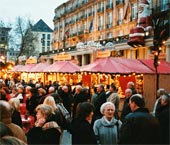German Christmas markets brighten up the winter gloom
 Berlin - Tourists are pouring into the German capital, bent on soaking up the fairyland atmosphere of Berlin's extraordinary range of Christmas markets.
Berlin - Tourists are pouring into the German capital, bent on soaking up the fairyland atmosphere of Berlin's extraordinary range of Christmas markets.
Christian Taenzler, the city's tourism marketing media manager, says there are close on 50 such markets, including one on Gendarmenmarkt, the city's most prestigious square.
A thriving trading point in earlier centuries, Gendarmenmarkt is renowned for its German-French church architecture and ornate concert hall.
Today it vibrates to the sound of Christmas carols as 150 stallholders sell hand-made toys, wooden nativity sculptures, hand- blown glassware and perfumed soap.
Jugglers with painted faces and comical cone-like hats perform as O Tannenbaum resounds across the square, and men and women in bizarre outfits stomp amongst the crowd on stilts.
Klaus Wowereit, Berlin's governing mayor, is kept busy at this time of year, skipping from one market to another to switch on the illuminations. Near the famous war-ruined Kaiser Wilhelm Memorial Church at another square called Breidtscheidplatz a huge Christmas tree sheds its light on the stalls.
"We have so many wonderful Christmas markets in Berlin," says Wowereit. "Who needs to go to New York to do one's Christmas shopping when there is so much on offer here?"
At Gendarmenmarkt, Lova Rimini from Fuchstal in Bavaria maintains the tradition of embroidered linen. Her stall is rich with the exquisite results of her efforts, including handbags, purses and pictures.
"Not many people do this this kind of embroidery anymore in Europe," she says, "so visitors are curious!"
Ernst Kraus, an Oberammergau-based Bavarian sculptor works feverishly at the market, displaying mangers, cribs, and other intricate, religious-related, wood carvings he has created.
"Things are rather quiet in Oberammergau at this time of year, so l always spend five weeks in Berlin in the run up to Christmas. I meet visitors from all parts of the world," he says, while chipping away at a large block of wood carved to resemble a lamb.
Kristin Reisch, the Gendarmenmarkt Christmas market spokeswoman, explains: "We are lucky. We have the most attractive location in Berlin for the market, which means we really do have to offer something very special."
"Stallholders mostly come from Germany, but there are also participants from India, South Africa, Denmark, Japan, England and the US," she says. "Bonn used to be the capital of West Germany, but now the country is reunited it's Berlin which calls the tune.
"It took a few years, but now it really is the nation's true capital, with some rich people arriving to give it more economic clout," she adds.
The Christmas market on Gendarmenmarkt was conceived six years ago. Besides its array of marquees, it also boasts a large stage - unusual at such events - where a band entertains visitors with popular tunes as well as Silent Night and other carols.
Germany has over 50 carols, most of them devoted to Mary and baby Jesus, with some taking the tunes of other songs and with different words.
O Tannenbaum, for example, was once a song of coachmen from the state of Hesse, while the tune for O du Froehliche was taken from a song sung by fishermen in Sicily.
Other notable Christmas markets in Berlin are to be found near Charlottenburg Palace, and at Spandau - near the site of the now demolished prison where Rudolf Hess spent his final years as the last jailed wartime Nazi.
Children love the Spandau market's bright lights, roasted sugared almonds and array of toys and trinkets. Elsewhere, on Unter den Linden, brass band music resonates as people hunt for bargains at a amid the smell of hot spiced wine, a traditional winter drink.
The linden trees on the city's famed boulevard are ablaze with twinkling lights, adding a touch of jollity to the sombre statue of Frederick the Great on horse-back.
Curiously, Germany's most celebrated Christmas market - Christkindlmarkt - after Christ the child - is not to be found in Berlin but in Nuremberg.
Opened on Friday night, it celebrates with typical Bavarian Catholic gusto. Copious quantities of sausages and beer are consumed.
A myriad range of Christmas toys are on offer - among them rotating nativity tableaux, driven by the rising heat from candles, and Hexenhaueschen - literally "little witches' houses."
Confectionery straight from Hansel and Gretl, the houses are made of ginger-bread spiced with cinnamon, with biscuits stuck on the roofs and walls, and great dollops of droopy icing to simulate icicles.
By December 6, the German Christmas season is in full swing, with the marking of St. Nicholas Day, when children clean a shoe - nowadays more likely to be a plastic boot - and leave it outside their bedroom door, hoping to find it full of sweets when they awake next morning. (dpa)